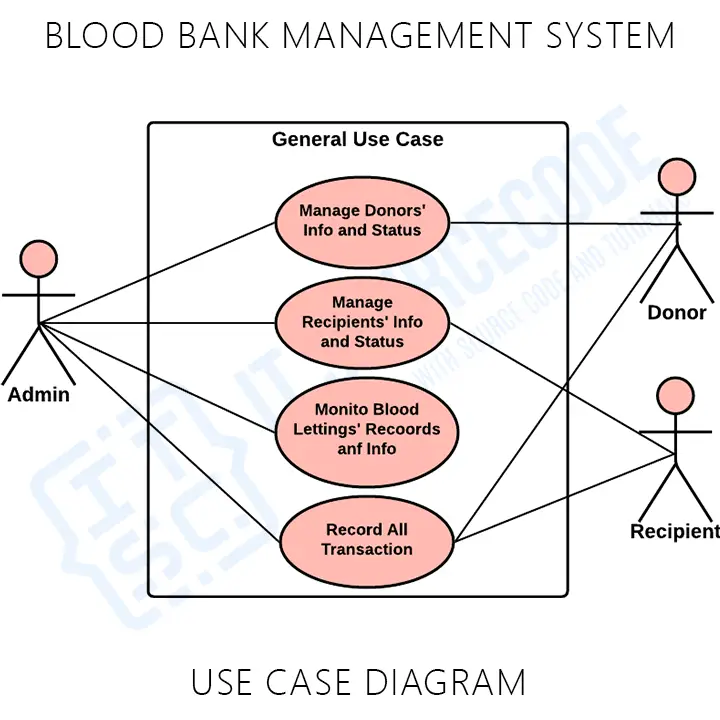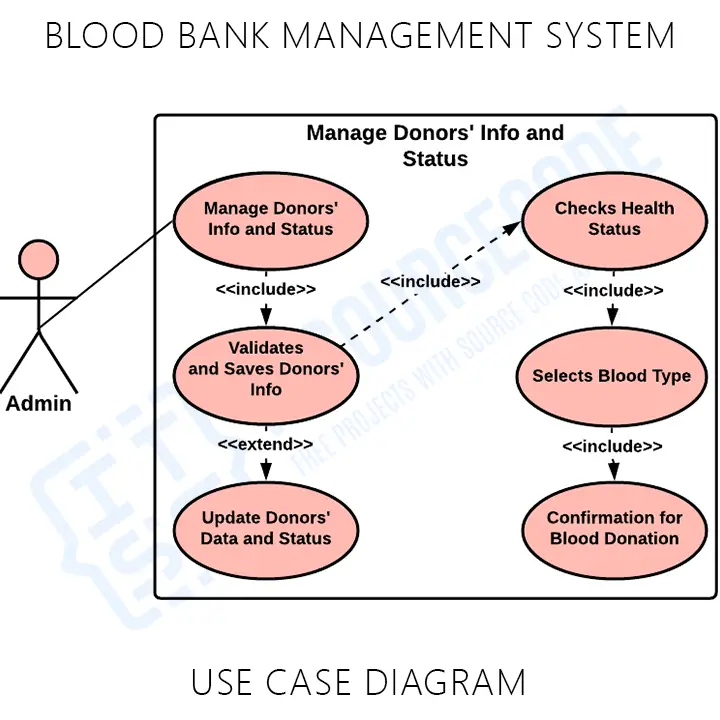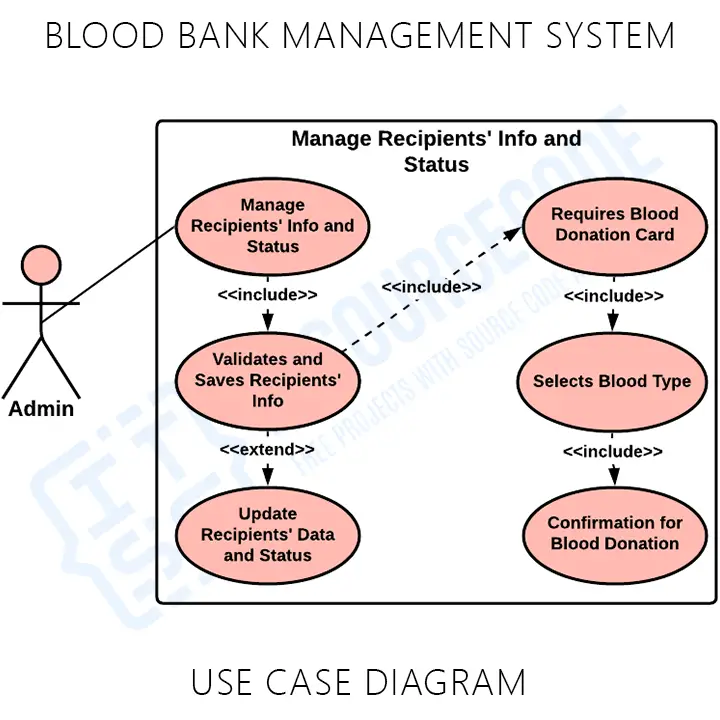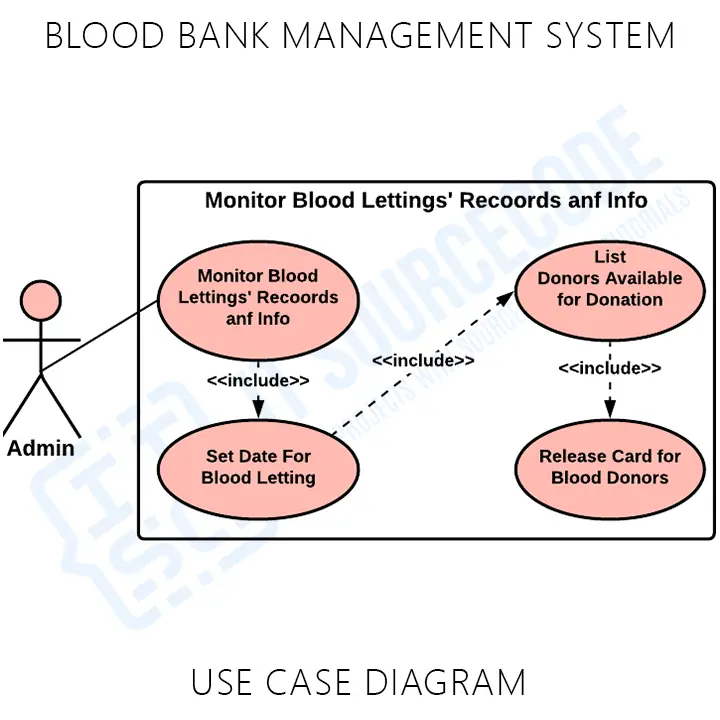The Blood Bank Management System Use Case Diagram is used to show the processes involved when users invoke the software. It depicts the structure of the system behavior.
Additionally, the diagram consists of processes (use cases) and users or “actors”. It uses defined symbols to describe the overall flow of the system.
Check out the related and suggested articles below to learn more about Diagrams and other topics.
- Blood Bank Management Project Use Case Diagram
- Blood Bank Management System UML Diagrams
- Activity Diagram for Blood Bank Management System
- ER Diagram for Blood Bank Management
- Online Blood Bank Management System Class Diagram
- Component Diagram for Blood Bank Management
- Deployment Diagram for Blood Bank Management
Project Overview
| Name: | Blood Bank Management System Use Case Diagram in UML |
| Users: | Hospital Admin, Bloodletting Admin, Donors, and Recipients. |
| Tools Used: | Any Diagram tools that provide use case diagram symbols. |
| Designer: | ITSourceCode.com |
What is a Use Case Diagram?
The use case diagram for blood bank management system shows the sample behavior of the software. It includes the project functions using use cases, actors, and their connections.
Moreover, the diagram assists you to define and organize project needs. This also provides a clear picture of the user and system relationships. Therefore, this diagram depicts the complex functions of a system including how the user reacts to it.
Importance of UML Use Case Diagram
Helping the developers and businesses with system management is one of the importance of the UML use case diagram. It includes the procedures from the viewpoint of users.
Furthermore, the diagram is the analysis method used to identify, clarify, and manage project needs. This diagram works best with other UML Diagrams for Blood Bank System. Other UML diagrams include activity, class, sequence, deployment, and component diagrams.
Blood Bank Management Use Case Diagram
The designed blood bank management system use case diagram has two main illustrations. These illustrations describe the system’s general and specific processes using include and extend.
Blood Bank Management System General Use Case Diagram
This diagram shows the general processes or functions of the system. Its processes are based on the transactions done in managing the Blood Bank donor’s and recipients’ information and status.

The general use case is the most common application of a use case diagram. The use case diagrams depict the system’s main components as well as the flow of information between them.
Use Case Diagram using Include and Extend
The use case diagram using include and extend is used to elaborate the proceeding diagrams. The terms include and extend in the use case diagram are known as indicators.
The label include indicates that the sub-processes of the main processes must be included to complete the task. Extend, on the other hand, declares that the sub-processes can only be performed when needed.
Manage Donors’ Information and Status Use Case Diagram
This is where the system admin manages the important information of the donors. It serves as a basis for the donor’s bloodletting transactions and information updates.

Manage Recipients’ Information and Status Use Case Diagram
Its process includes managing recipients’ information when requesting blood donations. The system validates the request and finds a match blood type to the request.

Monitor Blood Lettings’ Records and Status Use Case Diagram
This is the process where the admin gathers the information of all the donors and then stores it in the system. The information will serve as the basis for future transactions and updates.

You can add more to this illustration and it is up to you how will you create your diagram. But make sure to have precise information and consider the included use cases.
Use Case Diagram for Blood Bank Management System Pdf
How to draw a Use Case Diagram?
Time needed: 2 minutes
Here’s the complete guide on how to draw a use case diagram for blood bank management system.
- Step 1: Familiarize Use Case Diagram Symbols
For beginners, you need to familiarize first with use case symbols to be used.
- Step 2: Determine the system processes
The next step is to determine the system’s processes. They will be the use cases of your project.
You may ask the users about the typical activities done in blood bank management. - Step 3: Analyze the use cases included
The gathered information from the users needs to be evaluated to know the general use cases.
From the general use cases, you will see the sub-cases that are included. But, only include the useful processes related to the blood bank management system. - Step 4: Plot the Use Case Diagram
To plot the diagram you will need the users, use cases, container (scope), and their indicators (association). You will base the flow of use cases on the evaluated information from the users.
Your first move is to place the users involved.
Next, put the container in the plotted diagram to separate the objects (users and system) scope.
Then place the use cases of the blood bank management.
Finally, you need to map out the association of the use cases to show the interactions between the user/s and the system.
Conclusion:
One of the methods that contribute to blood bank management system development is the UML use case diagram. It helps developers know the possible inputs that the project should process and perform.
Furthermore, you will discover the needed processes and connect them to the other UML Diagrams. The diagram is also applicable in modeling the software’s use cases (processes). It captures the system’s flow from one process to the next.
Inquiries
If you have concerns about the Use Case Diagram for Blood Bank Management System, just leave us your comments below.

